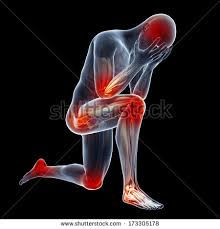Controlling Inflammation: Part 1: How it works
- Ginny Pomeroy MAPT, NTP, BCHN
- Apr 5, 2016
- 3 min read

As a Physical Therapist and a Nutritional Therapist, combating inflammation is part of my daily practice. So, discussing ways to combat inflammation that are in synchrony with our own natural healing powers is near and dear to my heart!!
First, lets look at how the inflammatory process works. (See "Inflammation: Do you have it?" here.)
Our bodies are uniquely equipped to heal tissues that become damaged as a result of injuries caused by trauma, infection, or irritation of any kind. The inflammatory response is the first line of defense against these insults and initiates healing by bringing an increased blood flow to the injured area. This allows our immune system to take charge of preventing infection and clearing out pathogens and other damaged tissue. This is a good thing, unless it doesn’t stop….

Problems with uncontrolled Chronic Inflammation occur when this process either does not or cannot stop because of a continued source of irritation or biochemical imbalances that prevent normal “anti-inflammation” processes from functioning normally. Chronic inflammation is associated with many disease processes (including arthritis, diabetes, heart disease, colitis, to name a few) and is responsible for huge health care costs, pain and suffering, and disruption in many people's lives.

So what can be done to help reduce the biochemical influences that make inflammation such a persistent source of pain and cellular irritation? From a nutritional standpoint, we want to up-regulate the anti-inflammatory pathways by giving our bodies the nutrients we need and down-regulate the pro-inflammatory pathways by reducing the biochemical substances that keep the fire burning!
Where do these pathways come from and how do they work?
These pathways are known as Prostaglandin pathways. Prostaglandins are a subset of localized tissue hormones that regulate all kinds of tissue responses including whether to increase or decrease inflammation in an area. Our bodies produce prostaglandins in our cells from essential fatty acids that we get from our diets.

The types of fats that we eat actually can dictate which pathways we have access to. SO, that means that if we eat a lot of high quality Omega 3 fatty acids such as fresh fish-oil, cod-liver oil, or krill-oil we can up-regulate our anti-inflammatory pathways.

There are many other factors that influence how these pathways function, including genetic factors, diet, and our own biochemical stores of certain enzymes, minerals, and vitamins.
Here is a link to a great article written by Sally Fallon and Mary Enig, PhD that does a great job of explaining more specific information about Prostaglandins:
Why not just take Anti-Inflammatory Medication? Sometimes use of medication is very appropriate and in some cases life-saving, so I'm not suggesting that these medications should never be used. But lets examine how 2 classes of drugs work in the body to reduce inflammation.
1.) Non-Steroidal Anti-inflammatory Drugs (NSAIDs) such as Aspirin, Ibuprophen, Aleve, and Naprosyn work to block the pro-inflammatory pathways, however they also disrupt our natural anti-inflammatory pathways. In addition, the same chemicals that control inflammation in our body (remember those prostaglandin pathways?), are also responsible for the protection of our stomach lining against the acid environment that is naturally there, as well as proper functioning of our kidneys. Therefore, when you block all the prostaglandin pathways at the same time, you also run the risk of damage to your stomach lining and/or difficulty with kidney function. In my humble opinion, the possible side-effects of long term use of NSAIDs (eg: digestive disorders, ulcers, bleeding, and kidney failure) make them a less desirable alternative to a more natural approach. Not to mention (again) how they dis-regulate your normal anti-inflammatory pathways.

2.) Corticosteroid Medications such as Prednisone, are powerful anti-inflammatories as well. They work differently than NSAIDs by taking a much more direct pathway to reduce inflammation. They actually suppress your immune system altogether. Long term use can reduce your resistance to infection as a result. Most often these drugs are prescribed in decreasing dose packs and only are used for the short term in hopes of decreasing acute inflammation. Sometimes, cortisone is injected into specific areas in the body to reduce localized inflammation.

So, what are some "natural" alternatives to medication for controlling Inflammation?

I would be remiss if I didn't mention ice. Ice temporarily decreases blood flow to an area (while the ice is administered) and then blood returns after the ice is removed. This helps to reduce inflammation especially in the acute phase of an injury.
Fortunately, there are other great ways to combat inflammation that have a much more long lasting effect....
Please continue in my next blog post to see how you can make dietary changes that will decrease inflammation!



Comments